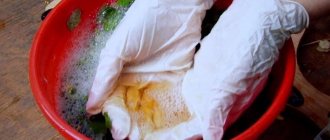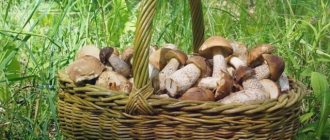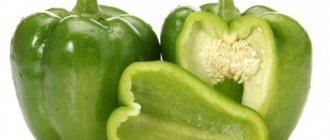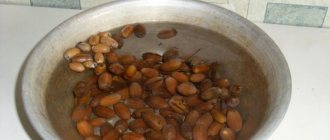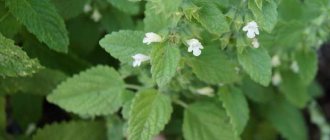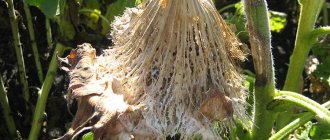Home / Pests and diseases
Back
Published: 06/06/2019
Reading time: 11 min
4
Bell peppers are grown by gardeners in all regions of Russia. To get a harvest, you have to work hard, including preserving the plants from insect attacks. A summer resident must know which sweet pepper pests pose a danger to plants, and how to quickly exterminate enemies on the site.
- 1 Aphid
- 2 Ants
- 3 Whitefly
- 4 Medvedka
- 5 Spider mite
- 6 Nematodes
- 7 Thrips
- 8 Scoops
- 9 Slugs
- 10 Wireworm
- 11 Pepper pests in greenhouses and beds
- 12 Prevention
Aphid
The number of species of this pest of garden, garden and indoor plants exceeds three thousand. Externally, insects look different, but usually they are small insects, up to 0.7-0.9 mm, with a soft transparent or greenish body. Aphid colonies are numerous, and therefore the damage caused by microscopic pests is enormous.
They suck out plant juices, turning pepper bushes full of life into wilted and pitiful skeletons. Aphids are also dangerous because they carry various fungi and viruses, infecting crops. How to fight the enemy:
- attract ladybugs, hoverflies, and lacewings to the garden plot, destroying aphids. To do this, fennel, caraway seeds, and ordinary dill are planted in the garden;
- Sprinkle the pepper with infusions of ash, tobacco, chopped garlic, and onions. Decoctions of tomato tops help (1 kg of tomato tops are poured with 2 liters of water, boiled, cooled), chamomile (100 grams per liter of water, infused for a day, diluted 1:3 with water, sprayed);
- plants are treated with Keltan, Fitoverm, Agravertin.
Colorado beetle
Who doesn’t know this “striped saboteur”? Of course, his main “dish” is potatoes, but in hungry years he does not disdain pepper. Adults, 7-12 mm long, are easily recognized by their black and white carapace and yellow cephalothorax with black dots. The larvae are larger - up to 15 mm, dark brown, lightening over time to an orange or pinkish tint.
It is easy to notice the Colorado potato beetle, but it is much more difficult to defeat it. To this day, no 100% means of protection has been developed - the beetle quickly develops resistance to chemicals, easily tolerates cold winters and is not a delicacy for birds and predatory insects. At the initial stage, bright yellow clutches of eggs are found on the inside of the leaves (one female can lay up to 1000 eggs per season). Afterwards, you can observe the larvae diligently gnawing leaves, shoots and leaf tips. Adult beetles, which live from 1 to 3 years, are also caught doing the same thing. Instead of a pepper bush, a gnawed “skeleton” remains.
Measures to combat the Colorado potato beetle:
|
Ants
Garden ants pose a danger to bell pepper plantings. Their harm lies in the fact that these insects feed on the sweet secretions of aphids, essentially encouraging an increase in the number of insect colonies. Where there are aphids, there will definitely be ants, as well as damaged bushes and various infections.
It is not difficult to notice insects, as they densely cling to the shoots of plants and busily run between the rows along the paved paths. The battle with them is difficult, and you must try to avoid the use of toxic pesticides.
Means of struggle:
- finding and destroying anthills and insect colonies;
- destruction of aphids;
- laying out baits (mix honey and ground borax) in places where ants accumulate.
Of the insecticides, Muraviin, Muratsid, Grom-2 are effective, but they are used only for large-scale insect attacks.
Whitefly
A dangerous pest that is not easy to detect in a greenhouse. But traces of the activity of whitefly larvae are clearly visible: withered, curled pepper leaves.
Small, up to 3-4 mm whitish butterflies lay eggs on the underside of leaves, from which numerous voracious larvae emerge. They suck out the juices of the plant, which leads to the death of the bushes. In addition, the larvae secrete sticky honeydew, in which pathogenic fungi thrive.
Pepper receives a double blow: from a pest and various diseases. As soon as a whitefly is noticed, it is necessary to urgently treat the plantings. For small numbers of insects, spraying with garlic infusion and a solution of laundry soap is suitable.
If the scale is large, chemical insecticides are used:
- Fufanon (once a season);
- Mospilan;
- Confidor.
On a note! Effectively used against whiteflies of beneficial insects: lacewings or ladybugs.
Terms and rules of therapeutic and preventive treatment
The key to a good harvest and healthy vegetable crops is timely and proper processing of the beds. But processing alone is not enough - it is important to know the technology and timing of such an event. When interacting with chemicals, it is important to remember the protective equipment, and it is also recommended to read the instructions first.
In greenhouses and greenhouses
Measures to protect beds in a greenhouse have their own nuances. Given the closed conditions, processing is carried out exclusively in a respirator and safety glasses. At the first signs of poisoning, the victim should immediately come out for air. It is worth remembering that a number of drugs harm bees. The cultivation of the area for sowing in the greenhouse is carried out two weeks before work begins in the garden. Immediately after digging, a biofungicide is applied - the product is added to the top layer of soil. In addition, in the fall the soil is treated with a weakly concentrated solution of Bordeaux mixture.
In the open ground
To protect vegetable beds, you should disinfect the soil in advance. Preventive treatments of garden plants begin in mid-October. In the autumn, the area will need to be treated with a solution of copper sulfate (1-2%). Next, special preparations are added - biofungicides. Thanks to these agents, pathogenic microorganisms are destroyed in the soil. Immediately after harvesting, garden beds must be sprayed with Fitosporin. Biological treatment begins 3 weeks before the first frost. Preventive or therapeutic treatment should be carried out in dry and windless weather.
Previous
PepperDiseases of bell and bitter pepper: treatment and prevention
Next
PepperHot pepper: how to plant and care for it in open ground
Medvedka
A large (6-8 cm) insect that looks like a crayfish is a serious threat to many garden plantings. It damages the root system of plants, moving away from danger into the depths of the soil. Peppers dry out and die.
Insects dig winding labyrinth passages, so you can only notice the presence of mole crickets on the site by leaving “paths” and holes with piles of earth on the surface. The fight against them includes the following measures:
- arrangement of manure traps in the ground, at a depth of 30-40 cm. Insects are attracted by the smell of manure, they crawl into one place and this makes it easier to exterminate a whole batch of mole crickets;
- mandatory plowing of the site in spring and autumn;
- loosening row spacing;
- treatment of earthen passages with soapy water.
The recommended drugs are Medvetox, Bankol, and Grizzly.
Spider mite
This microscopic pest is perfectly camouflaged, so it is not so easy to see. The color is variable: from green to brownish-brown. Traces of presence on plants: small yellowish dots on the stems and leaves of pepper (puncture marks), spider web threads.
The mite “works” on the underside of leaf blades, sucking cell sap from the tissues. The bushes lose their elasticity, wither, turn yellow and die.
Control measures:
- destruction of plants with traces of damage by spider mites;
- spraying the bushes with tobacco infusion (take about 400 grams of raw material per 10 liters of water, leave for 1.5-2 days, then boil for 2 hours, cool);
- soil treatment with granular agents Temik, Aldicarb;
- use of chemicals Inta-Vir, Karbofos.
Nematodes
It often happens that pepper bushes wither, dry out and wither. Outwardly, no damage is noticeable, and gardeners remain perplexed, believing that the plants have been infected by a fungus or virus. But most often the cause is root-knot nematodes that live deep in the soil. They damage the roots of plantings, turning healthy tissue into dried out and thinned threads.
When digging up plants damaged by nematodes, thickenings in the form of flasks of brown or yellowish color are visible on the roots. All that remains is to destroy such peppers, and be sure to replace the soil at the digging site.
Eliminating the pest is not easy, so it is advisable to prevent the appearance of nematodes on the site. To do this, equipment is disinfected, only healthy pepper seedlings are used for planting, and crop rotation is observed.
Sweet pepper diseases and their control
In addition to pests, peppers are susceptible to various diseases. The reasons for their appearance are the same as the reasons for the appearance of insects: improper care, contaminated soil, lack of fertilizing.
The most common diseases:
- Late blight. Appears as yellow-brown spots on leaves and fruits. Late blight is a fungus. Infection occurs through spores. Late blight often appears in greenhouses, as there is high humidity there. To combat, use ash solution or manganese. Photos of leaves affected by late blight are presented below.
- Powdery mildew is a virus. Looks like a white coating on the leaves. Dew appears due to an excess of nitrogen-containing fertilizers or non-compliance with crop rotation rules. An excellent way to combat powdery mildew is whey-based sprays.
- Black bacterial spot appears as small black spots on the fruit and stem. Soap sprays are used as a preventive measure. It is better to remove infected bushes from the garden and burn them.
Thrips
Representatives of fringed winged insects quickly fly (almost jump over) over pepper bushes, laying colonies of eggs.
Insects are small in size (up to 1-1.5 cm), a pair of wings, and small antennae. The larvae and adults suck the juice from the leaf blades, causing the plants to dry out and die. In addition, thrips often carry infections that are dangerous for peppers, aggravating the situation.
Control measures:
- spray the plantings with infusion of marigolds (tagetes): per liter of water - 300 grams of flowers, infuse for two days;
- installation of traps with sticky surfaces in greenhouses;
- To protect against pests, peppers are treated with infusion of garlic or onions.
The chemicals used to exterminate thrips are Confidor, Actellik, Karbofos, and Vertimek.
What remedies are there if the pepper is overpowered by pests?
The most effective pest control products are insecticides. However, it is difficult to use poisons at home. But among these drugs there are also those that have a natural composition. For example, “Fitoverm” and “Agravertin” are safe for indoor processing of peppers.
However, the processing of the plant should be carried out in the bathroom, where there is ventilation and it is convenient to clean the enamel surface after processing the bushes.
If you are still wary of purchased drugs, then there are effective folk remedies for pests. They will not give such a quick effect; several treatments will be required. But everything is natural and 100% safe.
Pepper light was overcome by pests
Soap infusion
This is the most popular home remedy for aphids. The bush should be washed with a soapy solution (30 g of grated laundry soap diluted in 1 liter of water). To do this, the pot is wrapped in film so that the soil is not covered with soap, and a soap composition is applied to the leaves and stems.
So the pepper should stand for about an hour, and then it is washed with a shower.
- A soap solution can also be made from liquid soap. In this case, you will need 1 tbsp. soap per 1 liter of water.
- Tar soap is very effective against aphids.
Garlic and onion infusion
Take 1 tsp. garlic juice, 2 tsp. onion juice, 1 tsp. dandelion stem ground in a blender. Mix all this and dilute it in water (½ l). This composition should be sprayed on the plant.
It is worth warning right away that the garlic aroma from the pepper bush after such processing will be clearly noticeable. However, it is this smell that repels pests from plants.
Pepper infusion
It can be made from the hot fruits of the pepper itself. Or take a chili pod. Grind one fruit in a blender and infuse it in a liter of water for 24 hours. Then add 1 tbsp to the infusion. liquid soap.
We spray the pest-infested bush with the resulting composition, paying attention to the back side of the leaves, where the young aphids hide.
Milk-iodine solution
As an irrigation preparation, a milk-iodine solution against aphids and many other sucking pests is very effective. It is easy to prepare. Add 0.5 ml of iodine to 100 ml of milk.
We dilute the resulting mixture in 1 liter of water and treat the infected bushes with this product.
Soda solution
This solution is also often used to treat fruit plants against pests. For 1 liter of water you will need 1 tsp. with a heap of baking soda.
Plants need to be sprayed with this solution several times, with a break of 3-5 days.
Mustard solution
If mustard powder (10 g) is diluted in water (1 l), you will get a very effective and, most importantly, natural remedy for pests.
Peppers should be sprayed with this mixture as insects appear.
Folk remedies if pepper light is overcome by pests
Scoops
Inconspicuous gray-brown butterflies become active at night. Fertile females lay colonies of eggs, from which hundreds of greenish ribbed caterpillars emerge in early summer. The larvae devour leaves, shoots, and ovaries of peppers and damage developing fruits.
In favorable conditions, two generations of caterpillars may appear over the summer, causing enormous damage to garden plantings. When the number of insects is small, they are collected manually, and the plants are sprinkled with water. It is recommended to dig up the beds in the fall and install traps with sweet molasses, which attracts caterpillars.
On a note! Regular weeding and destruction of quinoa and nettles, on which the cutworm lays eggs, also leads to a reduction in the number of pests.
In extreme cases, chemicals are used:
- Volaton;
- Sherpa;
- Arrivo;
- Decis;
- Zolon.
Slugs
Do not underestimate slugs, which outwardly look quite harmless. Mollusks without shells emerge at night, most often attacking young bushes of peppers and other plants. After such “crawls”, round holes, slimy traces and insect excrement remain on the leaves.
During the day, slugs hide under lumps of earth, plant debris, and planks on ridges. Their comfortable environment is dense plantings and high humidity. Death under natural conditions occurs on hot days, and during prolonged rains the slugs become active.
To destroy the pest, folk remedies are used:
- surround the pepper plantings with grooves, pouring tobacco, lime, and ground red pepper into them;
- dust the plants with ash;
- after watering or rain, sprinkle the ground around the plantings with quicklime and superphosphate granules (slugs get burned on the abdomen and die);
- The ridges are treated with Groza, Meta, and Predator preparations.
Wireworm
The larvae of the click beetle, known as wireworms, love to eat the roots of sweet peppers. Caterpillars with a hard brown-orange body reach 1-4 mm at different periods of life. The larval stage lasts up to 4 years, during which time the pest parasitizes garden plants, damaging root systems and underground parts of stems.
The wireworm causes the most serious damage to potato beds, but other representatives of the nightshade family - tomatoes, bell peppers - suffer more than that. The fight against wireworms is lengthy, especially if a large number of the pest has accumulated on the site.
Effective ways:
- manual autumn digging of soil with sampling of wheatgrass roots;
- sowing mustard near the beds, the smell of which wireworms cannot stand;
- treating the soil against diseases and pests before planting with a saturated solution of potassium permanganate;
- adding ash and lime to the soil.
Judging by the reviews of gardeners, many got rid of click beetle larvae using the drugs Prestige, Bazudin, Provotox. But when using chemicals, do not forget to follow the instructions.
What harm is done to the plant?
Pests eat leaves, roots, stems, and suck out the juice. This weakens the plant and slows growth . Insects spoil flowers. Fewer ovaries are formed. There are few peppers on the bushes. The caterpillars spoil the fruits themselves, eat away the insides, and fill them with their feces.
Pests (aphids, thrips) produce honeydew and create good conditions for fungal growth. Bushes damaged by pests are susceptible to diseases:
- gray rot;
- bacterial wilt;
- cladosporiosis;
- late blight
Leaf-eating insects
You can tell by the pepper leaves in the holes that there are insects in the greenhouse (garden bed). It becomes clear who is gnawing after a careful examination of each bush.
Colorado beetle
Dangerous pest. Colorado potato beetle larvae eat leaves and stems. In a short period of time, bare twigs may remain from the pepper bush. The body length of an adult beetle is 7-12 mm, width - 7 mm. It has 5 black stripes on each elytra. The abdomen is light orange with rows of black spots, the back is yellowish-black.
The head is wide with bean-shaped eyes and antennae, it is yellow in color, covered with bright black spots.
There are hooks on the legs (there are 3 pairs of them), with their help the Colorado potato beetle slowly moves along the surface of the leaves. The wings are membranous. The beetle is capable of making long flights.
Adults live from 1 to 3 years, overwinter in the soil at a depth of 50 cm. Adults mate in the spring. Females lay eggs on the back of leaves. They are easy to spot. They are dark yellow, almost orange. Beetle larvae go through several stages of development.
| Stage | Color | Body size |
| 1 | Dark grey | 2.5 mm |
| 2 | Red | 4.5 mm |
| 3 | Red-yellow | 9 mm |
| 4 | Orange | 16 mm |
Larvae of the 3rd-4th stage of development are able to move. Pupation occurs in the ground. An adult beetle emerges from the pupa after 3 weeks.
Slugs
Gardeners will know about the appearance of these mollusks in their greenhouse by holes eaten away in the leaves, excrement, and mucous secretions. Slugs come out to eat at night. During the day they hide in holes, under boards, plant remains and stones.
Mollusks are very voracious, willingly eating tender shoots, leaves and fruits of pepper. They have a soft body 50-60 mm long. Greenhouses and greenhouses are favorite habitats for slugs. These leaf-eating pepper pests like moist soil and do not like heat.
Caterpillars
Signs of caterpillars on pepper: holes in the fruit, corroded stems, leaves gnawed from the edges. In a greenhouse, caterpillars often eat bushes. They are comfortable indoors. There the humidity is higher and there is less sun. Caterpillars emerge from eggs laid by butterflies. In search of food, these insects are able to crawl long distances. There are 2 types of damage to peppers in dachas:
- gray caterpillars of the winter cutworm butterfly feed at night, spend the day in the ground, it is difficult to find and destroy;
- green with gray speckles caterpillars of the gamma moth butterfly.
See also
Characteristics of hybrid Hercules pepper, cultivation and care rules
Read
Butterflies actively breed in the spring (April, May), in the second half of summer and in September.
Other insects that harm bell peppers
The greatest damage to pepper is caused by the mole cricket, cutworm, thrips, and Colorado potato beetle. Other lovers of sweet pepper leaves and fruits reduce the quality of the fruit and spread the infection.
Ants
These insects do not need a description. All gardeners know them. Garden ants build their anthills along the perimeter of the ridges. They especially like to live in a greenhouse next to wooden sides. The passages are easy to notice, as are the ants scurrying along the stems.
It is not the ants themselves that cause the damage. Peppers are harmed by aphids, which, thanks to their protection, multiply intensively. It feeds on plant sap, weakens the plant, and carries a fungal infection.
Whitefly
Small (3-5 mm) butterfly of pale color (white, light yellow). It harms peppers indirectly. Adults colonize the inner surface of leaves. In the process of life, a sweet secretion is released - honeydew.
Pepper leaves become sticky. Conditions are created for the proliferation of powdery mildew, gray rot, and mosaic fungi. Bushes infested with whiteflies suffer from infection. White-yellow leaves appear on them. After some time they darken and die.
Nematodes
These are microscopic-sized worms (1-2 mm). They are almost transparent, live in the soil, and feed on pepper roots. The plant lacks moisture and nutrients and looks sick:
- curled leaves;
- yellow leaves;
- growth retardation;
- absence of flowers, ovaries.
If you pull out a bush affected by nematodes, you can see yellow-brown thickenings on the roots. The root part dies, the roots become thinner, and the plant dies.
May beetle larva
The roots of the pepper suffer from the larvae of the May beetle; they gnaw them. The damaged plant gradually withers and dies. It is difficult to fight larvae. They live deep (0.7 m) in the soil. They are easy to recognize. These are white worms with black heads and 3 pairs of legs. The clutch of a female pest contains up to 70 eggs. Pest larvae enter the garden along with fresh manure.
Medvedka
A large insect up to 8 cm in size. The mole cricket lives underground. In the garden bed where it started, you can find winding passages. The insect feeds on roots and earthworms. Peppers with a damaged root system have a depressed appearance, do not develop, and die. The bear has:
- wings, with the help of which she migrates;
- limbs with which she digs the ground;
- a good appetite.
Spider mite
Eats juice. Especially loves young leaves on seedlings. Pepper leaves turn yellow and curl. On the back side you can see the insects themselves, a thin, light-colored web and light or dark dots - the places of bites. Signs of a large number of insects:
- change in color of the aboveground part of the pepper;
- leaves wither and fall off;
- the ovaries do not form, the fruits do not develop.
Wireworm
Peppers are threatened by larvae that live in the ground. A wireworm is the name given to the larva of a click beetle. These are yellow or brown worms from 1 to 4 cm long. It takes 4 years before moving to the next stage. The wireworm overwinters in the soil and goes to a depth of 60 cm. Pepper bushes develop poorly and die due to roots eaten by larvae.
scoop
In nature, there are about 100 varieties of butterflies. It is not they that threaten the plant, but the caterpillars that hatch from the eggs. The dangers of caterpillars and common cutworm species are described above. In the southern regions of the Russian Federation, the winter armyworm is widespread:
- wingspan up to 45 mm;
- hind wings white;
- the forewings are brown with spots outlined in black.
Gamma armyworm is found everywhere:
- wingspan up to 47 mm;
- hind wings gray-yellow;
- the forewings are gray-brown or brown, with light spots shaped like a “Y”.
Aphid
The insect settles on young leaves. First, the apical part of the bush suffers. The leaves curl, dry out, and fall off.
Aphids are small insects that feed on sap. It multiplies quickly. A plant affected by aphids is susceptible to fungal infection.
The bush can die both from lack of nutrition and from infection caused by aphids. To see aphids, you need to look at the inside of the leaf. There you can see small insects (0.5 mm) of green or dark color, sticky secretions - honeydew, egg laying, larvae.
See also
TOP 30 best varieties of sweet peppers for greenhouses with descriptions
Read
Thrips
Small (0.5-1.5 mm) almost transparent insects with wings. It's difficult to see them. In search of food, they flit from one plant to another. Peppers are harmed by adults and larvae. In those places where they sucked out the juice, traces remain - stains. They merge into a pattern resembling yellow stripes.
The entire above-ground part of the pepper suffers from thrips. Leaves fall off and immunity decreases. The plant can die from either exhaustion or infection. Thrips are carriers of many dangerous diseases.
Pepper pests in greenhouses and beds
In most regions of Russia, the heat-loving crop is grown indoors, less often in open-air ridges. Pests are equally dangerous for all plants, but some are more common in greenhouses, others on the ground.
In greenhouses and polycarbonate, film greenhouses, peppers are most often threatened by whiteflies and spider mites. Aphids, spider mites, and mole crickets attack the ridges. Pests often attack seedlings at home on window sills (aphids, spider mites), moving to seedlings from indoor plants.
Factors that provoke insect infestation
Plant parasitic insects pose a great threat to vegetable crops. And, of course, gardeners are interested in where parasites come from.
The main reasons that provoke the appearance of insects on the site include the following factors:
- wind transfer of pests from another area;
- acquisition of infected plants;
- transfer of larvae by ants;
- lack of timely measures to treat the site and planted crops;
- lack of agrotechnical measures to care for the plant;
- adverse weather conditions;
- dense planting and neglect of beds by weeds;
- high percentage of soil moisture;
Even planting vegetable crops in a greenhouse does not guarantee the absence of various pests. Many parasites spend the winter in warm and windless places (tree bark, unharvested plant tops), and with the onset of the first warm days they begin to parasitize the garden plot.
Prevention
As the experience of summer residents shows, it is easier to prevent pests from appearing on peppers than to desperately fight colonies of caterpillars, clouds of butterflies and herds of aphids.
Basic Rules:
- compliance with alternating plantings on the site;
- use of healthy seed material, high-quality seedlings;
- disinfection of soil, equipment, shelter structures;
- preventive spraying with soap, tobacco solution, ash infusion;
- inspection of plantings for damage, presence of larvae, caterpillars;
- compliance with pepper planting patterns and distances between seedlings;
- correct modes of watering, fertilizing crops, eliminating drought, excess moisture in the soil;
- weeding and loosening.
Numerous pests that threaten pepper must be destroyed. For this purpose, folk remedies, various traps, and professional insecticides are used. The sooner the fight is started, the better the result and the less crop loss.
Natalia Severova
